POP TIPS: August Orchard Care
23 views
Skip to first unread message
Phil Forsyth
Aug 2, 2024, 3:55:26 PM8/2/24
to Philadelphia Orchard Group
Dear Philly Orchardists,
August is another exciting month for harvests, with the last berries and stone fruits ripening, followed later in the month by early apples, pears, Asian pears, and main crop figs!
Please check out our POP Monthly Orchard Task List for recommended maintenance activities to complete this month (the July/Aug list is also attached below).
Here is some more detail on some of the key tasks for Aug:
Orchard Watering
New plantings (from this spring or last fall) should be watered thoroughly once per week throughout the summer months. In most years in our wet climate, established orchard plantings don't require much in the way of supplemental watering except in the case of extended drought. However, in hot dry periods extending more than 2 or 3 weeks, some older orchard plants would also be glad of some additional water. Check your orchard plants for drooping leaves or other signs of plant stress.
Summer Weeding
Summer Bramble Pruning
By August, second year canes of raspberries will have finished fruiting and begun to die back. These dead canes can be pruned out anytime between late summer and late winter. For blackberries, tip back first year canes (non-fruiting) to encourage greater side branching for next year's harvest.
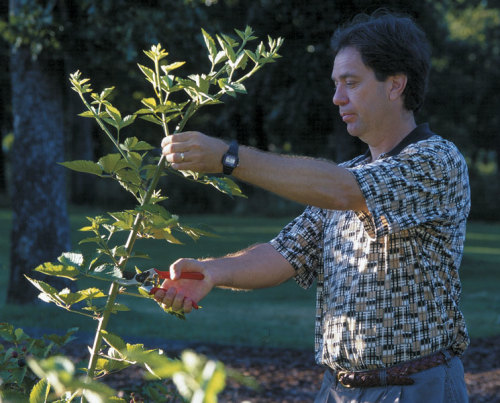
Emergency Pruning
During the summer months, most pruning should be limited to emergency pruning only.
Keep an eye out for any diseased, damaged, or dead wood that should be pruned away no matter the season. Pay special attention to the base of trees - especially of the stone fruit varieties: apricots, peaches, plums, nectarines - and prune away root suckers, the quick upright growth that can be a cover for dreaded borers, which make a home beneath trunk wood.
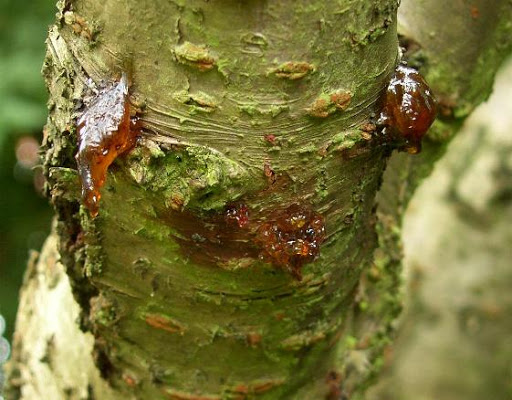
Bacterial canker on cherry and other stone fruits can often be identified by gummosis or oozing sap. This disease is best cut out using a sharp sanitized knife during hot,dry weather.
Pest and Disease Monitoring & Identification
Many orchard pests and diseases are active throughout the summer months and it is important to continue weekly monitoring of your plants to identify and manage challenges. POP has developed some new resources to help guide management of some of the most common pest and disease challenges affecting fruit trees in Philadelphia.
Here are the new videos POP created in partnership with Big Picture Alliance:
And here are POP's new Action Plans for Diseases:
And new Action Plans for Insect Pests:
Codling Moth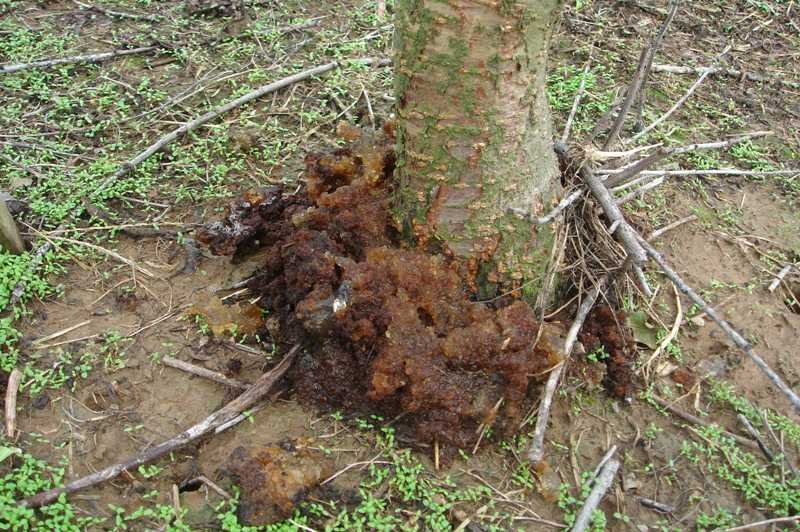
Keep an eye out for peach tree borer damage at the base of all stone fruit trees from summer through fall! Unlike most insect pests, borers can actually rapidly kill an established tree if left unchecked. Use a flexible wire to kill any active larvae and read more about preventative measures for borers here.
Observe your orchard regularly throughout the year for pest and disease problems, identify and respond appropriately. We've been distributing physical copies to community partners, but you can also check out POP's Scouting Guides for pest and disease management available for download on our website:
The guides include lots of photos and a description of how to identify the particular pest or disease and the damage caused by it. Proper identification is essential to treating these problems, as each has its own unique options for management! Once you have identified a pest or disease, you can then consult our website for management recommendations by using our search function:
Remove Damaged and Dropped Fruit
Although the ideal time for thinning fruit has passed, it is still advisable to continue to monitor your developing crops for insect and disease damage and remove the affected fruit. Similarly, it is best to gather any fallen fruit to avoid the further spread of pest and disease challenges. All fruit should be disposed of by adding to a hot compost system, feeding to poultry, or bagging up to remove from the site.
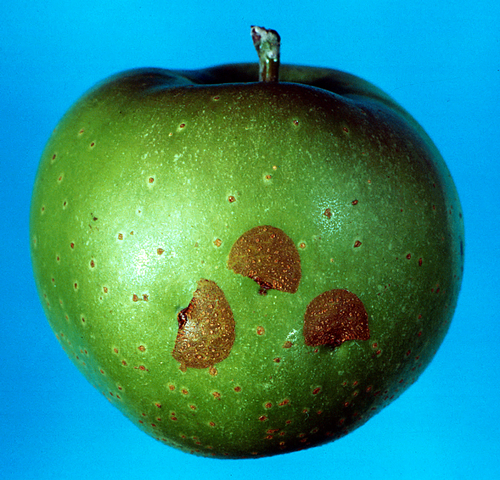
Distinctive crescent shaped scars from the Plum Curculio weevil can be found on pome and stone fruits. Remove affected fruits, dispose of dropped fruit, and watch out for a second generation of this common pest in late July and August! Note that stone fruits are much more susceptible to curculio damage, so you might ignore a few scars on apples and pears.
Summer Harvests!
Look out for ripening blackberries, peaches, plums, figs, Asian pears, pears, apples, grapes, cornelian cherries, jujubes, elderberries, rose hips, chokeberries, maypops, perennial herbs and greens, and more! Record your harvests using our handy POP Harvest Tracking Sheet.
Enjoy the summer harvests and stay cool in the heat!
Phil Forsyth, Co-Executive Director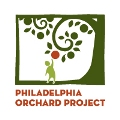
Philadelphia Orchard Project
Pronouns: he/him
Phil Forsyth
Aug 4, 2025, 10:26:14 AMAug 4
to Philadelphia Orchard Group
Dear Philly Orchardists,
August is another exciting month for harvests, with the last berries and stone fruits ripening, followed later in the month by early apples, pears, Asian pears, and main crop figs!
Please check out our POP Monthly Orchard Task List for recommended maintenance activities to complete this month (the July/Aug list is also attached below).
Here is some more detail on some of the key tasks for Aug:
Orchard Watering
Check out POP's new resource on orchard irrigation, with more info on watering established plantings! We developed this after last year's historic drought and requests for more guidance from our community orchard partners.
New plantings (from this spring or last fall) should be watered thoroughly once per week throughout the summer months. In Philadelphia’s generally humid, wet climate, we have long advised that you don’t need to water mature orchard trees unless there is drought. But extreme weather conditions have become our norm. Rainfall has become less predictable, heat more intense, and drought more of the rule than the exception. Plan on needing to irrigate your orchard at some point during the year and be prepared for longer periods of drought.
Orchard Watering Schedule
*Potted plants and raised beds will require more frequent watering: the smaller the container or higher the bed, the more often it will need watering
Again, see our new Orchard Irrigation resource for more details!
Summer Weeding
POP also created a brand new resource on Orchard Weed Management to better support our partners and Lead Orchard Volunteers in this important task!
Summer Bramble Pruning
By August, second year canes of raspberries will have finished fruiting and begun to die back. These dead canes can be pruned out anytime between late summer and late winter. For blackberries and black raspberries, tip back first year canes (non-fruiting) to encourage greater side branching for next year's harvest.

Emergency Pruning
During the summer months, most pruning should be limited to emergency pruning only.
Keep an eye out for any diseased, damaged, or dead wood that should be pruned away no matter the season. Pay special attention to the base of trees - especially of the stone fruit varieties: apricots, peaches, plums, nectarines - and prune away root suckers, the quick upright growth that can be a cover for dreaded borers, which make a home beneath trunk wood.

Bacterial canker on cherry and other stone fruits can often be identified by gummosis or oozing sap. This disease is best cut out using a sharp sanitized knife during hot,dry weather.
Additional summer pruning in July and early August can also be done to remove watersprouts, the upright vertical growth on tops of branches. The advantage of pruning this growth in summer is that it is less likely to grow back as vigorously, since the spring season of rapid growth is already past. Be careful to sanitize your tools to avoid spreading disease!
Pest and Disease Monitoring & Identification
Many pest and disease challenges continue into the summer months! POP has developed some new resources to help guide management of some of the most common challenges affecting fruit trees in Philadelphia.

Keep an eye out for peach tree borer damage at the base of all stone fruit trees from summer through fall! Unlike most insect pests, borers can actually rapidly kill an established tree if left unchecked. Use a flexible wire to kill any active larvae and read more about preventative measures for borers here.
Observe your orchard regularly throughout the year for pest and disease problems, identify and respond appropriately. We've been distributing physical copies to community partners, but you can also check out POP's Scouting Guides for pest and disease management available for download on our website:
The guides include lots of photos and a description of how to identify the particular pest or disease and the damage caused by it. Proper identification is essential to treating these problems, as each has its own unique options for management! Once you have identified a pest or disease, you can then consult our website for management recommendations by using our search function:
Remove Damaged and Dropped Fruit
Although the ideal time for thinning fruit has passed, it is still advisable to continue to monitor your developing crops for insect and disease damage and remove the affected fruit. Similarly, it is best to gather any fallen fruit to avoid the further spread of pest and disease challenges. All fruit should be disposed of by adding to a hot compost system, feeding to poultry, or bagging up to remove from the site.

Distinctive crescent shaped scars from the Plum Curculio weevil can be found on pome and stone fruits. Remove affected fruits, dispose of dropped fruit, and watch out for a second generation of this common pest in late July and August! Note that stone fruits are much more susceptible to curculio damage, so you might ignore a few scars on apples and pears.
Summer Harvests!
Look out for ripening blackberries, peaches, plums, figs, Asian pears, pears, apples, grapes, cornelian cherries, jujubes, elderberries, rose hips, chokeberries, maypops, perennial herbs and greens, and more! Record your harvests using our handy POP Harvest Tracking Sheet.
Enjoy the summer harvests and stay cool in the heat!
Phil Forsyth, Co-Executive Director
Philadelphia Orchard Project
Pronouns: he/him
Reply all
Reply to author
Forward
0 new messages
